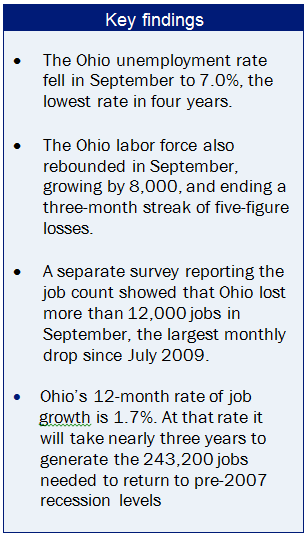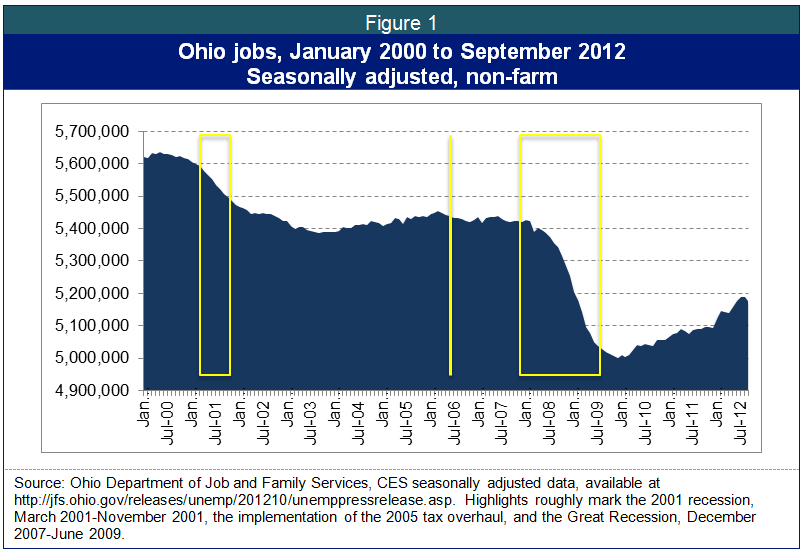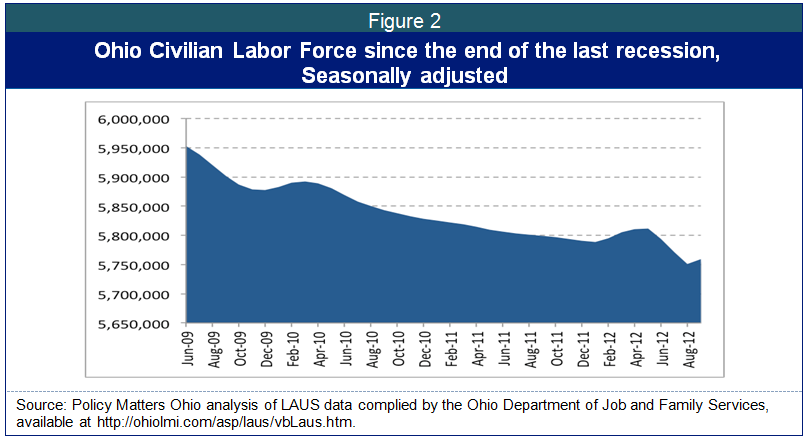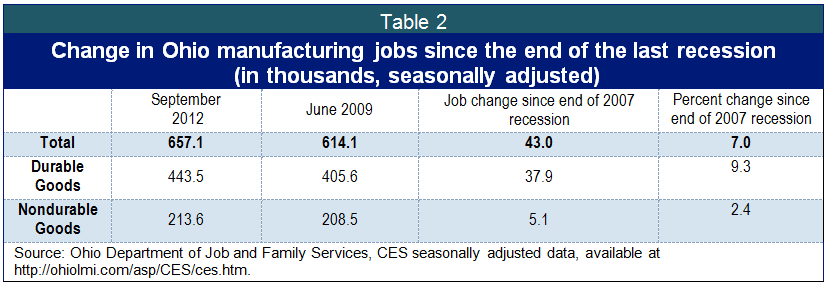
Ohio job data send a mixed message
October 19, 2012
Ohio job data send a mixed message
October 19, 2012
Press releaseAt the rate of growth seen over the last 12 months in Ohio, it will take nearly three years to generate the additional 243,200 jobs needed to return our state to pre-2007 recession levels of employment.
Download report
Data from two separate surveys released by the Ohio Department of Job and Family Services (ODJFS) today present a mixed message on the state job market in September. ODJFS’s survey of households shows another drop in the Ohio  unemployment rate, which fell 0.2 percentage points to 7.0 percent. This is the lowest the unemployment rate has been since September 2008. The household survey brought additional good news in that the Ohio labor force increased in September, by 8,000, ending the state’s three-month run of five-figure losses in the labor force.
unemployment rate, which fell 0.2 percentage points to 7.0 percent. This is the lowest the unemployment rate has been since September 2008. The household survey brought additional good news in that the Ohio labor force increased in September, by 8,000, ending the state’s three-month run of five-figure losses in the labor force.
A separate survey, the establishment survey, which provides the job count by surveying firms, tells a very different story. The establishment survey shows that the state lost more than 12,000 jobs in September. This is the largest single month drop in jobs since July 2009.
While it is frustrating to job-watchers looking for trends in job growth, conflicting survey data are not unusual. The monthly numbers are always preliminary and subject to revision. Last month’s originally reported job loss of 2,000 jobs was revised to a job gain of 400, so it is ill-advised to make too much of month-to-month changes. The surveys may tell conflicting stories because they survey different groups. The establishment survey carries more statistical weight because it is based on a much larger sample size than the household survey. It is for that reason that this report tends to focus on the establishment data.
On the other hand, the household survey includes trends in self-employment and agricultural work, both of which are not measured in the establishment survey. The establishment survey also has difficulty measuring employment at new firms, and according to the Secretary of State’s office, new firm filings increased in September and are outpacing last year’s filing rate. Thus, at certain times, the household survey may capture job growth that is not seen in the survey of employers.
Based on this month’s establishment report, the slow but steady job growth seen over the past month appears to be wavering. August’s gain of 400 jobs was disappointing and September’s reported loss is certainly a move in the wrong direction.
Over the last twelve months, the state job total has grown by 88,700 jobs, or 1.7 percent. At that rate of growth it will take nearly three years to generate the additional 243,200 jobs needed to return Ohio to pre-2007 recession levels of employment. That figure would be even higher if population growth were taken into account.
Figure 1 shows Ohio’s long slog out of the recession. The figure highlights changes in the Ohio job market from key points in time, including the recessions that began in 2001 and 2007, and the 2005 approval of a major state tax overhaul, which promised speedier economic growth. These figures include the latest seasonally adjusted data from the monthly survey of employers (Current Employer Survey) done by ODJFS in co-operation with the U.S. Bureau of Labor Statistics.
Table 1 details these changes. Not only is the state struggling to recover from the 2007 recession, Ohio never recovered from the 2001 recession, having lost more than 414,700 jobs since that recession began. Since the start of the 2007 recession, the state has lost 243,200 jobs. The state job count is also down 4.4 percent since the approval of the 2005 tax overhaul. If today’s job losses hold, September will erase more than a quarter of the job gains made over the summer, making today’s report somewhat concerning. The state is a long way from recovery.
The household survey revealed that the state’s labor force, the number of people working or actively looking for work, reversed course in September. The increase of 8,000 is the largest monthly gain since March, and a break in the three-month trend of five-figure losses. Figure 2 shows the remarkable decline of Ohio’s civilian labor force since the end of the recession in 2009. Over the last twelve months, the state’s labor force has shrunk by 40,000 workers.
Some of the people leaving the labor force are choosing retirement, or to work in the home taking care of aging family members or children. Others may return to school to retrain for a different career. Many people, particularly during prolonged periods of high unemployment, stop seeking work and ‘drop out’ of the labor force. Some are simply too discouraged to continue searching, applying, and receiving rejections.
Manufacturing, which has been one of the primary drivers of Ohio’s recovery, saw a decline of 6,400 jobs in September. Table 2 shows changes in Ohio manufacturing jobs since the end of the last recession.
As Table 2 shows, durable goods manufacturing, which includes the auto-supply chain and appliance manufacturing, has been the source of much of Ohio’s manufacturing growth since the end of the last recession. Even with a loss of 6.500 jobs in September, the sector is still up by more than 9 percent.
The Worker Adjustment and Retraining Notification Act (WARN) protects workers and communities by requiring employers with more than 100 employees to provide 60 days’ advance notice of plant closures or mass layoffs. Federal, state, and local government entities are not covered. WARN triggers rapid response services, which can include layoff aversion, training and dislocated worker assistance. As Table 3 shows, only one WARN Act notice was filed with ODJFS in September, impacting 160 workers, none of whom are in a union.
Conclusion
September’s report is truly a hodgepodge. The household survey delivered one of the most positive reports this year, with unemployment dropping to 7.0 percent and an increase in the labor force. Taken on its own it is very good news for the state. The establishment survey, often the more reliable of the reports, was in high contrast, showing one of the largest drops in employment since 2009. The one thing that is clear from this month’s report is that Ohio’s economy is fragile and we remain a long way from full recovery. We need increased investment, not austerity, to restore our communities and grow good jobs.
JobWatch is an ongoing project of the Economic Policy Institute (http://www.epinet.org) and Policy Matters Ohio, (http://www.policymattersohio.org). Both are nonprofit policy research institutes.
Tags
2012Hannah HalbertJobWatchWork & WagesPhoto Gallery
1 of 22




